TOYOTA LAND CRUISER 2021 Owners Manual (in English)
Manufacturer: TOYOTA, Model Year: 2021, Model line: LAND CRUISER, Model: TOYOTA LAND CRUISER 2021Pages: 632, PDF Size: 13.87 MB
Page 521 of 632
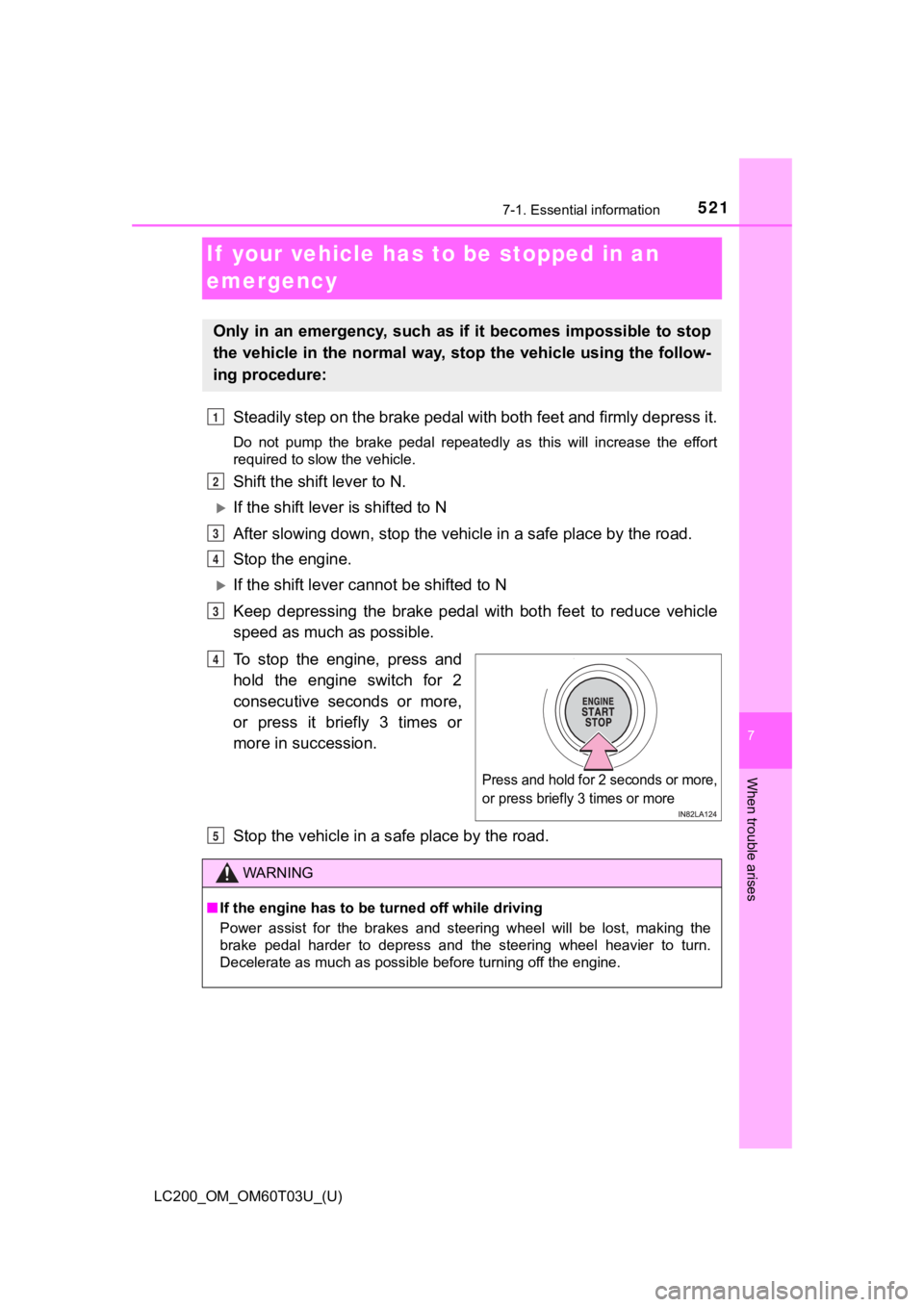
521
LC200_OM_OM60T03U_(U)
7
When trouble arises
7-1. Essential information
If your vehicle has to be stopped in an
emergency
Steadily step on the brake pedal with both feet and firmly depress it.
Do not pump the brake pedal repeatedly as this will increase th e effort
required to slow the vehicle.
Shift the shift lever to N.
If the shift lever is shifted to N
After slowing down, stop the vehi cle in a safe place by the road.
Stop the engine.
If the shift lever cann ot be shifted to N
Keep depressing the brake pedal with both feet to reduce vehicl e
speed as much as possible.
To stop the engine, press and
hold the engine switch for 2
consecutive seconds or more,
or press it briefly 3 times or
more in succession.
Stop the vehicle in a s afe place by the road.
Only in an emergency, such as if it becomes impossible to stop
the vehicle in the normal way, st op the vehicle using the follow-
ing procedure:
1
2
3
4
3
Press and hold for 2 seconds or more,
or press briefly 3 times or more
Q
WARNING
■ If the engine has to be tu rned off while driving
Power assist for the brakes and steering wheel will be lost, making the
brake pedal harder to depress and the steering wheel heavier to turn.
Decelerate as much as possible before turning off the engine.
5
Page 522 of 632
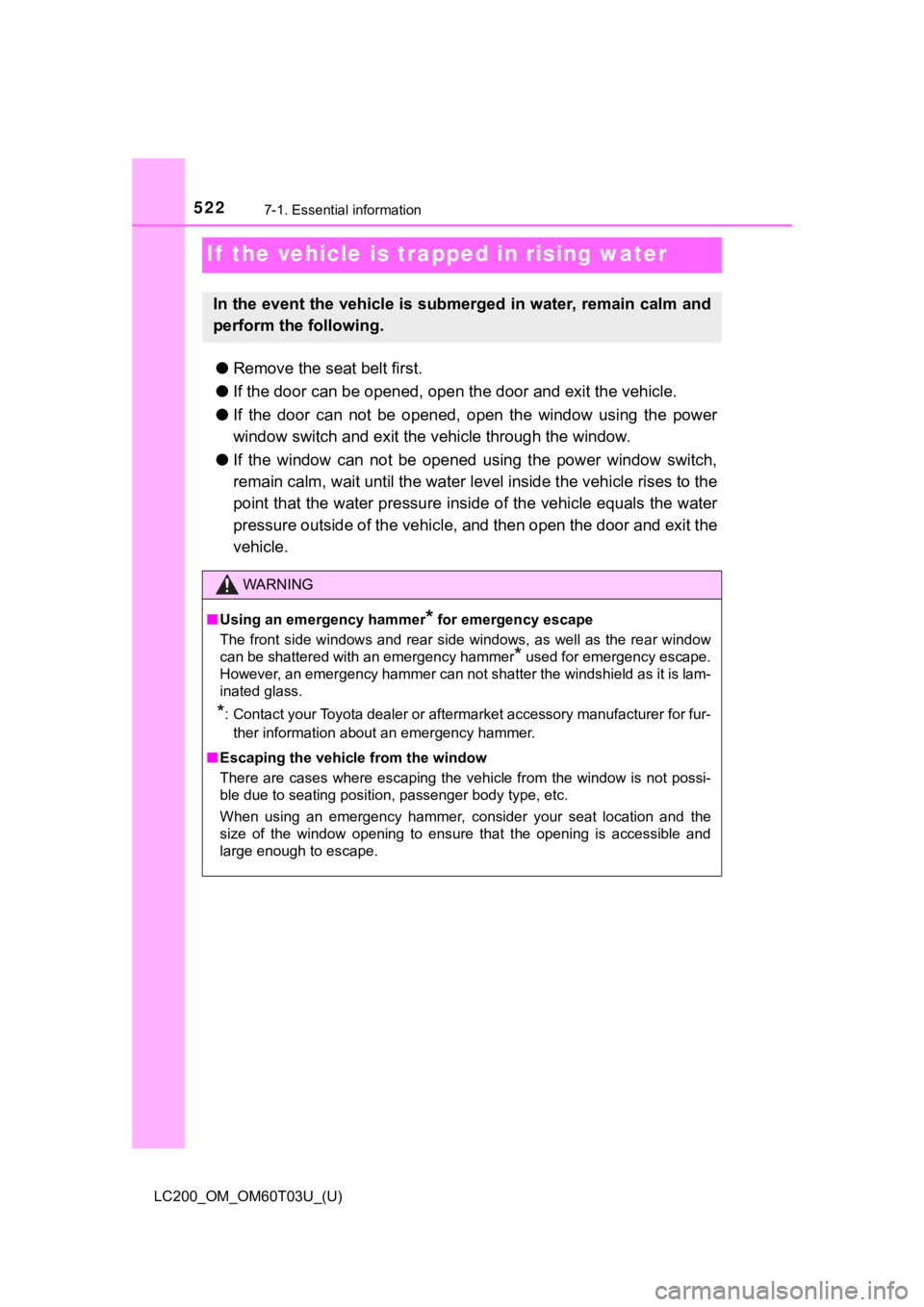
522
LC200_OM_OM60T03U_(U)
7-1. Essential information
If the vehicle is trapped in rising water
●Remove the seat belt first.
● If the door can be opened, open the door and exit the vehicle.
● If the door can not be opened, open the window using the power
window switch and exit the vehicle through the window.
● If the window can not be opened using the power window switch,
remain calm, wait until the water level inside the vehicle rise s to the
point that the water pressure i nside of the vehicle equals the water
pressure outside of the vehicl e, and then open the door and exi t the
vehicle.
In the event the vehicle is submerged in water, remain calm and
perform the following.
WARNING
■ Using an emergency hammer* for emergency escape
The front side windows and rear side windows, as well as the re ar window
can be shattered with an emergency hammer
* used for emergency escape.
However, an emergency hammer can not shatter the windshield as it is lam-
inated glass.
*: Contact your Toyota dealer or aftermarket accessory manufacturer for fur-
ther information about an emergency hammer.
■ Escaping the vehicle from the window
There are cases where escaping the vehicle from the window is n ot possi-
ble due to seating position, passenger body type, etc.
When using an emergency hammer, consider your seat location and the
size of the window opening to ensure that the opening is accessible and
large enough to escape.
Page 523 of 632
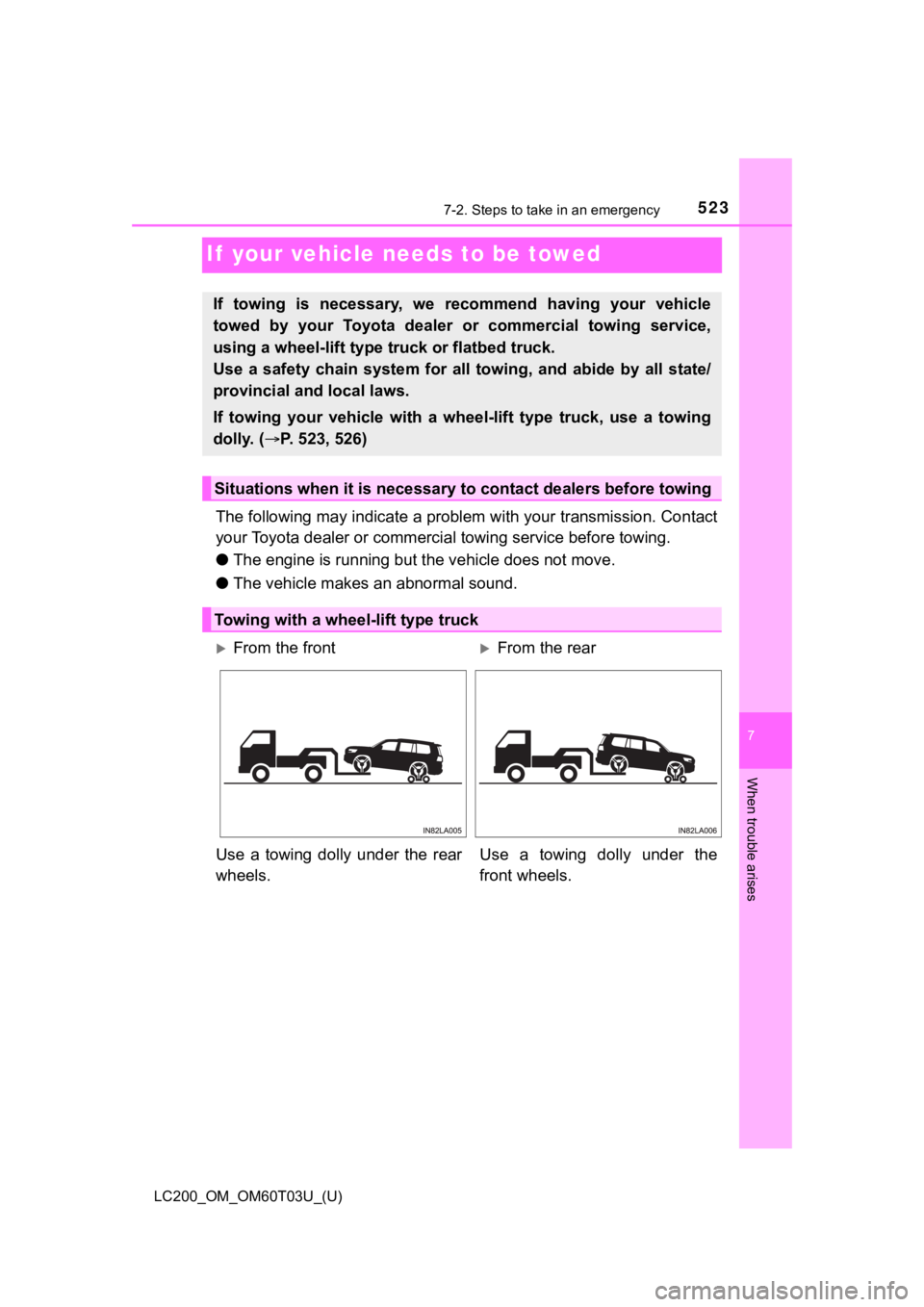
523
LC200_OM_OM60T03U_(U)
7
When trouble arises
7-2. Steps to take in an emergency
If your vehicle needs to be towed
The following may indicate a problem with your transmission. Contact
your Toyota dealer or commercial towing service before towing.
● The engine is running but t he vehicle does not move.
● The vehicle makes an abnormal sound.
If towing is necessary, we recommend having your vehicle
towed by your Toyota dealer o r commercial towing service,
using a wheel-lift type t ruck or flatbed truck.
Use a safety chain system for all towing, and abide by all stat e/
provincial and local laws.
If towing your vehicle with a wheel-lift type truck, use a towi ng
dolly. ( P. 523, 526)
Situations when it is necessary to contact dealers before towing
Towing with a wheel-lift type truck
From the frontFrom the rear
Use a towing dolly under the rear
wheels. Use a towing dolly under the
front wheels.
Page 524 of 632
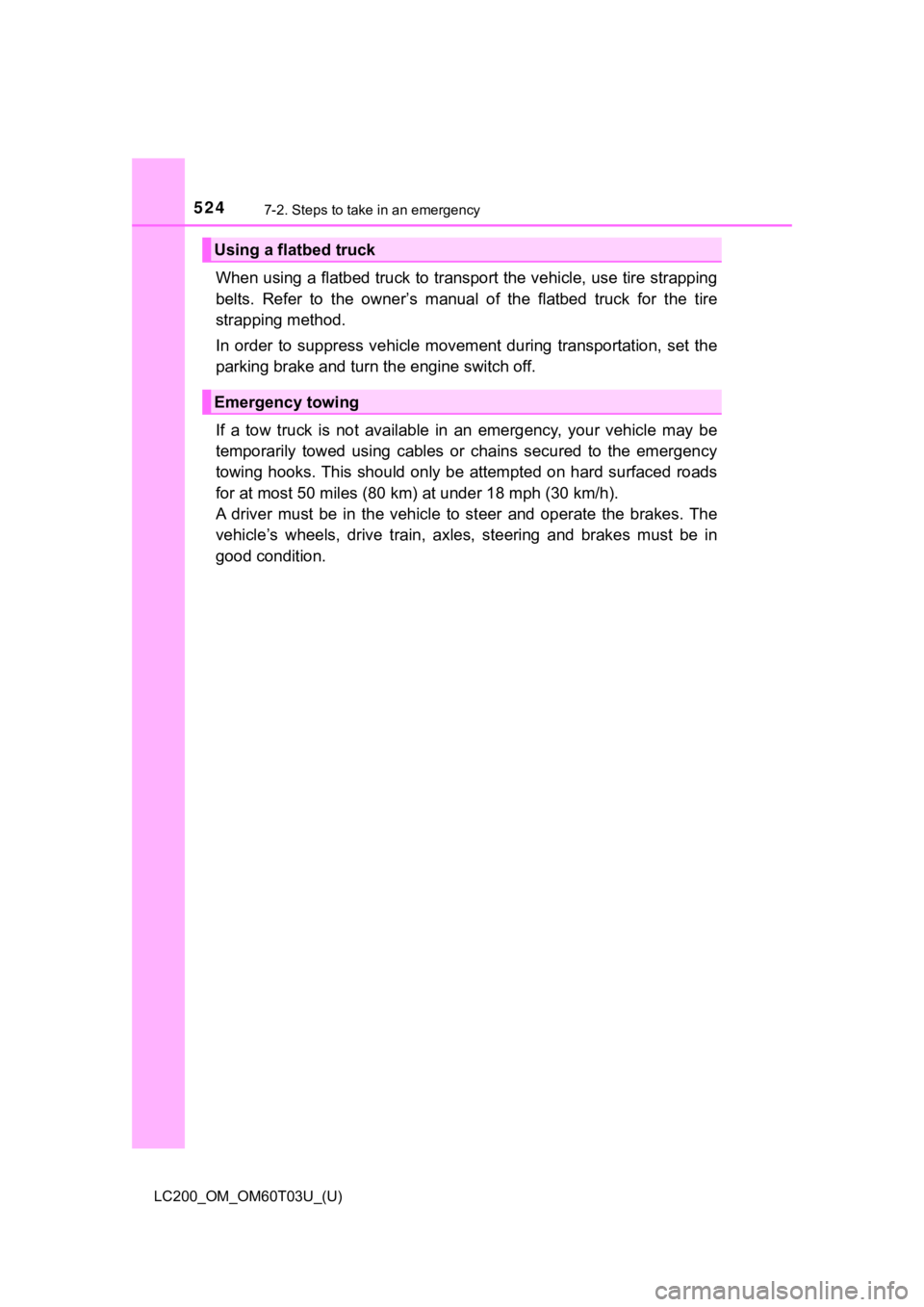
5247-2. Steps to take in an emergency
LC200_OM_OM60T03U_(U)
When using a flatbed truck to transport the vehicle, use tire strapping
belts. Refer to the owner’s manual of the flatbed truck for the tire
strapping method.
In order to suppress vehicle movement during transportation, se t the
parking brake and turn the engine switch off.
If a tow truck is not available in an emergency, your vehicle m ay be
temporarily towed using cables or chains secured to the emergen cy
towing hooks. This should only be attempted on hard surfaced roads
for at most 50 miles (80 km ) at under 18 mph (30 km/h).
A driver must be in the vehicle to steer and operate the brakes . The
vehicle’s wheels, drive train, a xles, steering and brakes must be in
good condition.
Using a flatbed truck
Emergency towing
Page 525 of 632
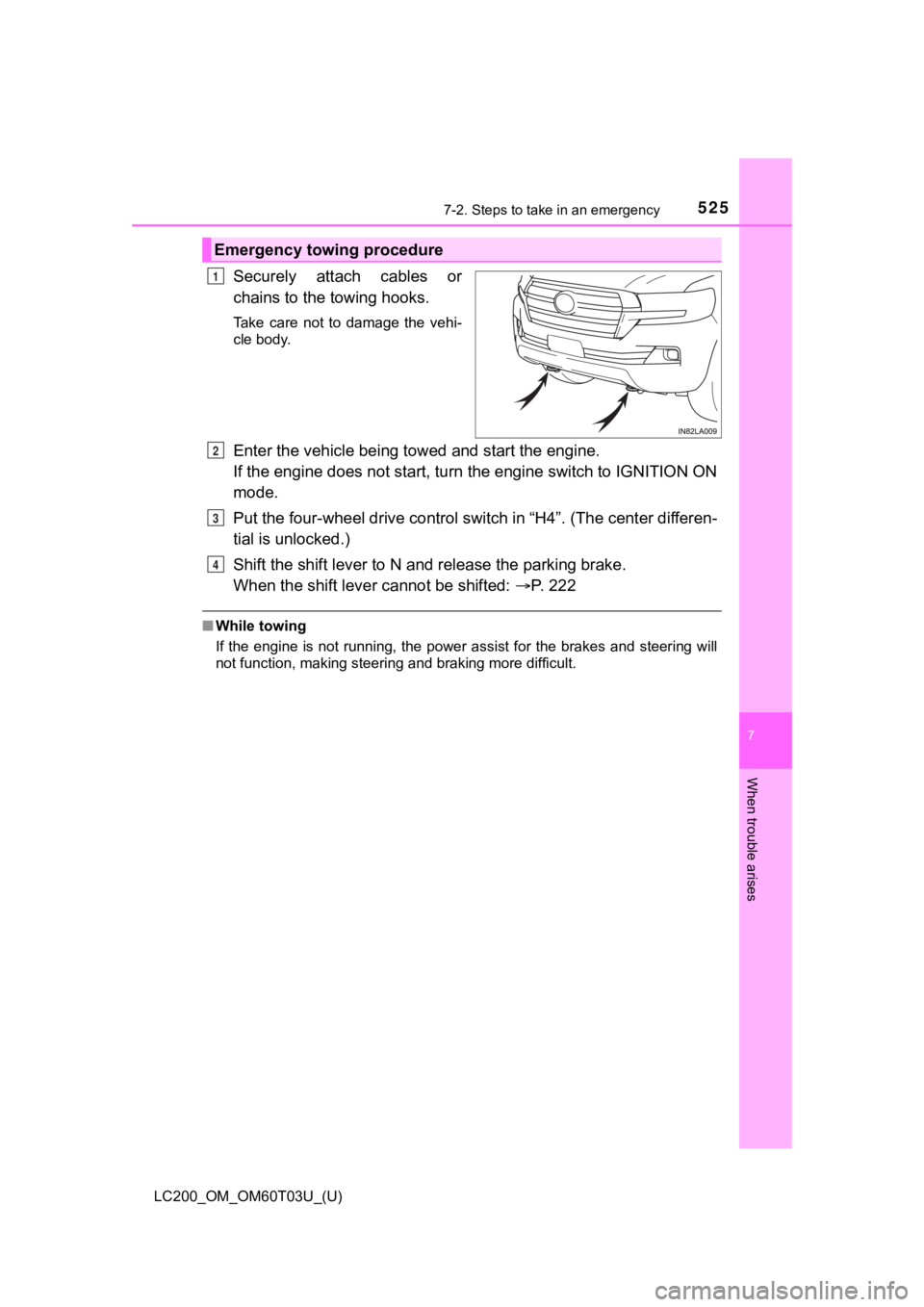
5257-2. Steps to take in an emergency
LC200_OM_OM60T03U_(U)
7
When trouble arises
Securely attach cables or
chains to the towing hooks.
Take care not to damage the vehi-
cle body.
Enter the vehicle being towed and start the engine.
If the engine does not start, turn the engine switch to IGNITIO N ON
mode.
Put the four-wheel drive control switch in “H4”. (The center di fferen-
tial is unlocked.)
Shift the shift lever to N and release the parking brake.
When the shift lever cannot be shifted: P. 2 2 2
■While towing
If the engine is not running, the power assist for the brakes a nd steering will
not function, making steering and braking more difficult.
Emergency towing procedure
1
2
3
4
Page 526 of 632
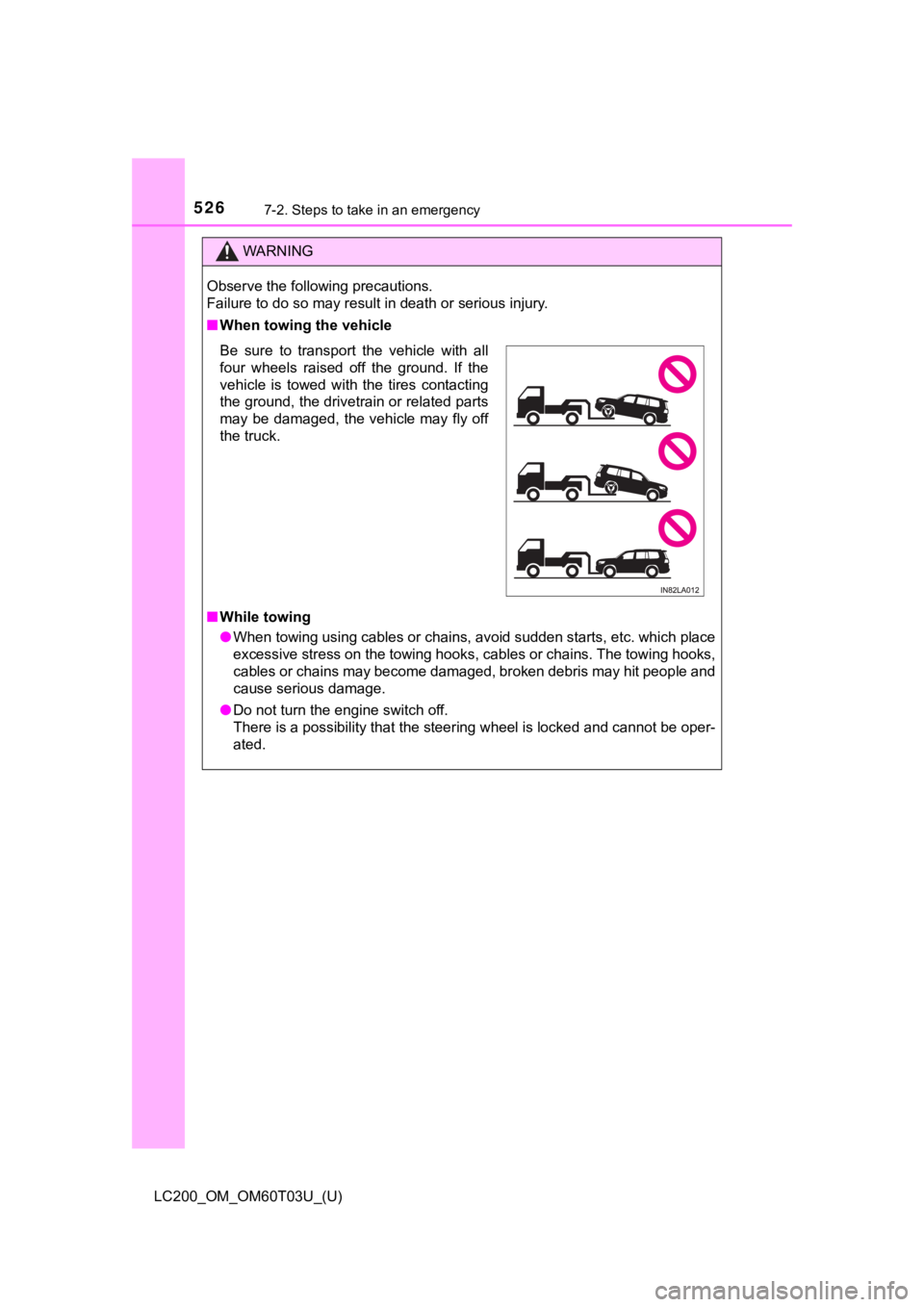
5267-2. Steps to take in an emergency
LC200_OM_OM60T03U_(U)
WARNING
Observe the following precautions.
Failure to do so may result in death or serious injury.
■When towing the vehicle
■ While towing
● When towing using cables or chains, avoid sudden starts, etc. w hich place
excessive stress on the towing hooks, cables or chains. The tow ing hooks,
cables or chains may become damaged, broken debris may hit peop le and
cause serious damage.
● Do not turn the engine switch off.
There is a possibility that the steering wheel is locked and ca nnot be oper-
ated.
Be sure to transport the vehicle with all
four wheels raised off the ground. If the
vehicle is towed with the tires contacting
the ground, the drivetrain or related parts
may be damaged, the vehicle may fly off
the truck.
Page 527 of 632
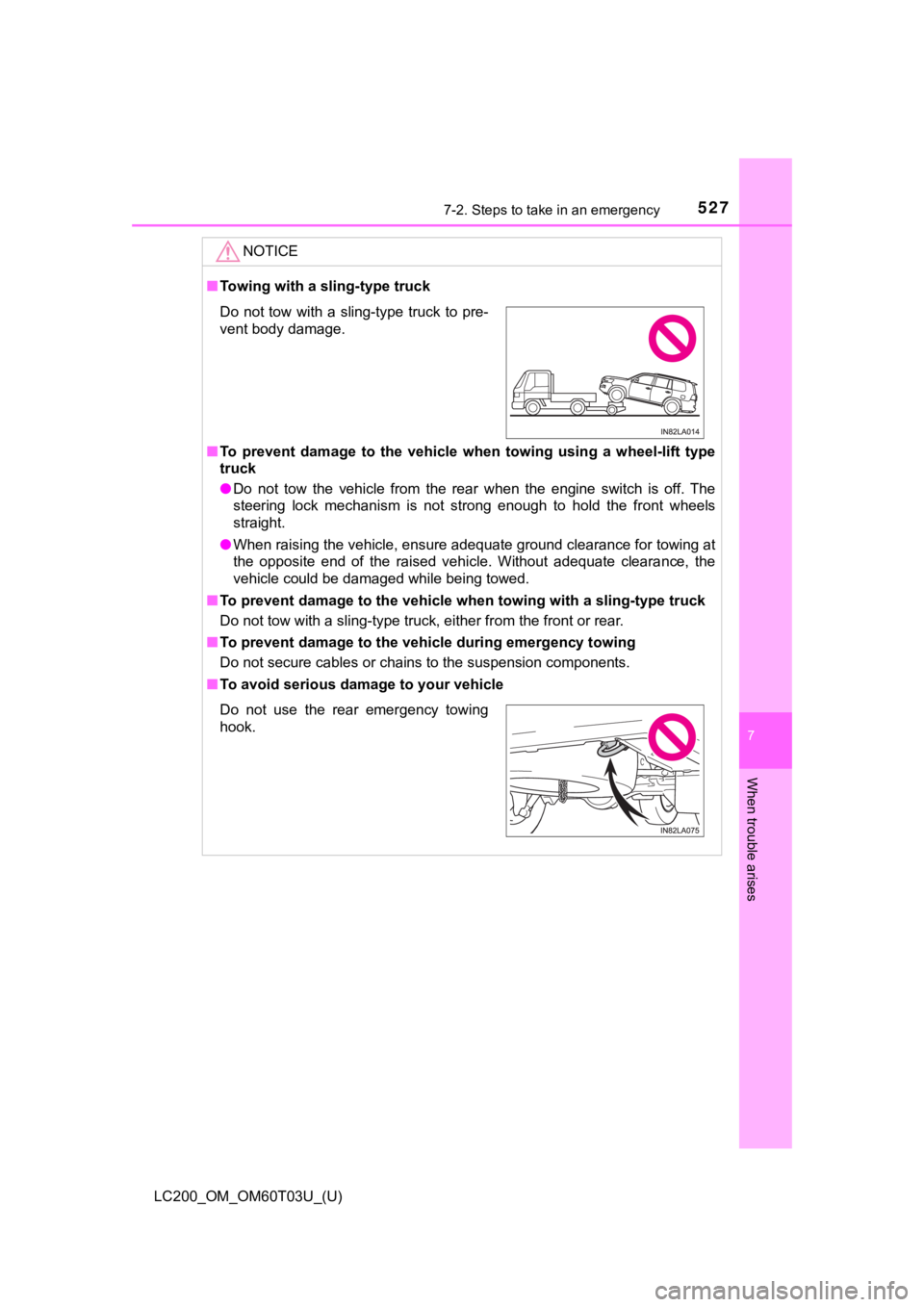
5277-2. Steps to take in an emergency
LC200_OM_OM60T03U_(U)
7
When trouble arises
NOTICE
■Towing with a sling-type truck
■ To prevent damage to the vehicle when towing using a wheel-lift type
truck
● Do not tow the vehicle from the rear when the engine switch is off. The
steering lock mechanism is not strong enough to hold the front wheels
straight.
● When raising the vehicle, ensure adequate ground clearance for towing at
the opposite end of the raised vehicle. Without adequate clearance, the
vehicle could be damaged while being towed.
■ To prevent damage to the vehicle when towing with a sling-type truck
Do not tow with a sling-type truck, either from the front or re ar.
■ To prevent damage to the vehic le during emergency towing
Do not secure cables or chains to the suspension components.
■ To avoid serious damage to your vehicle
Do not tow with a sling-type truck to pre-
vent body damage.
Do not use the rear emergency towing
hook.
Page 528 of 632
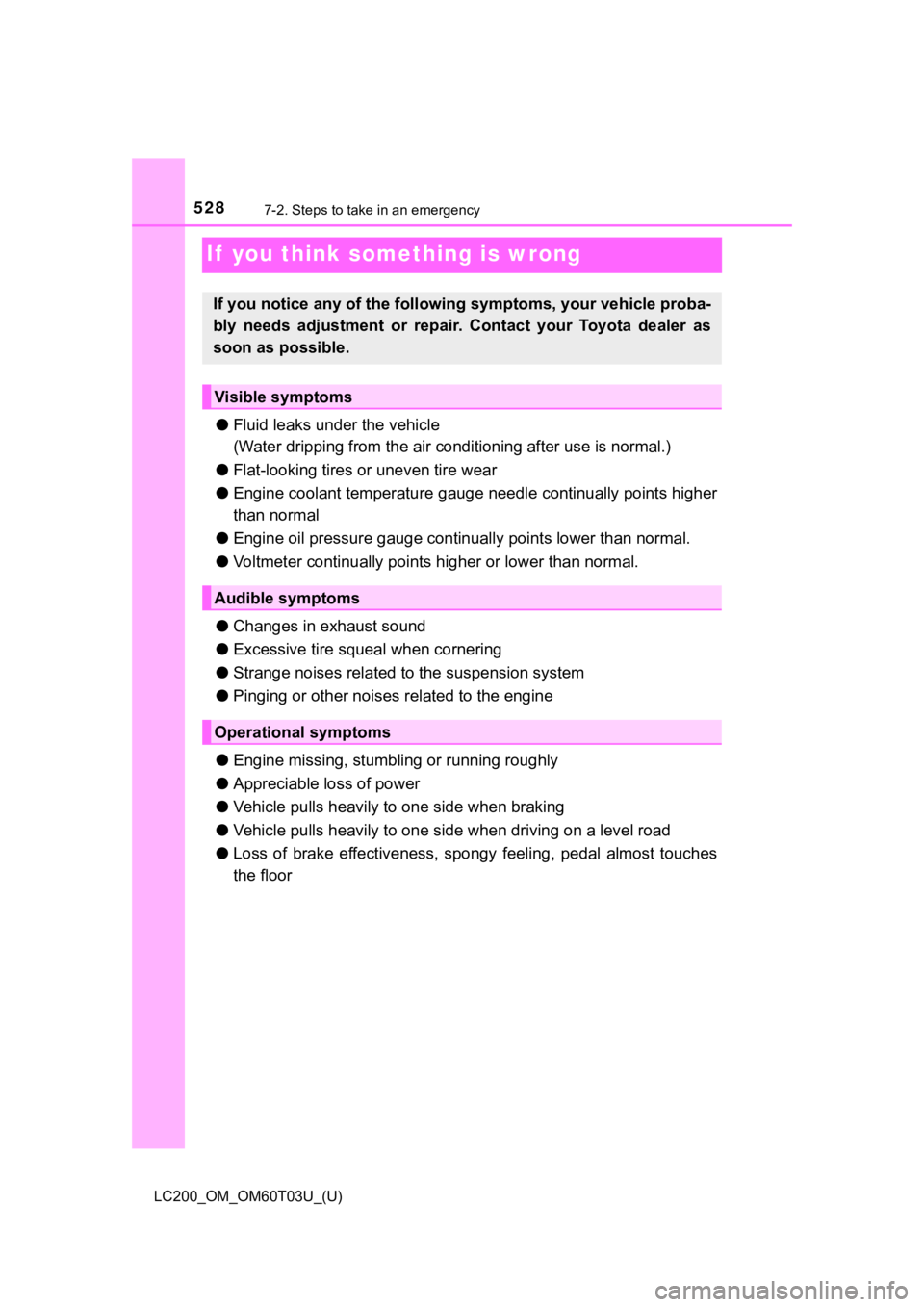
528
LC200_OM_OM60T03U_(U)
7-2. Steps to take in an emergency
If you think something is wrong
●Fluid leaks un der the vehicle
(Water dripping from the air conditioning a fter use is normal.)
● Flat-looking tires or uneven tire wear
● Engine coolant temperature gauge needle continually points high er
than normal
● Engine oil pressure gauge contin ually points lower than normal.
● Voltmeter continually points higher or lower than normal.
● Changes in exhaust sound
● Excessive tire squeal when cornering
● Strange noises related to the suspension system
● Pinging or other noises related to the engine
● Engine missing, stumb ling or running roughly
● Appreciable loss of power
● Vehicle pulls heavily to one side when braking
● Vehicle pulls heavily to one s ide when driving on a level road
● Loss of brake effectiveness, spongy feeling, pedal almost touch es
the floor
If you notice any of the followi ng symptoms, your vehicle proba -
bly needs adjustment or repair. Contact your Toyota dealer as
soon as possible.
Visible symptoms
Audible symptoms
Operational symptoms
Page 529 of 632
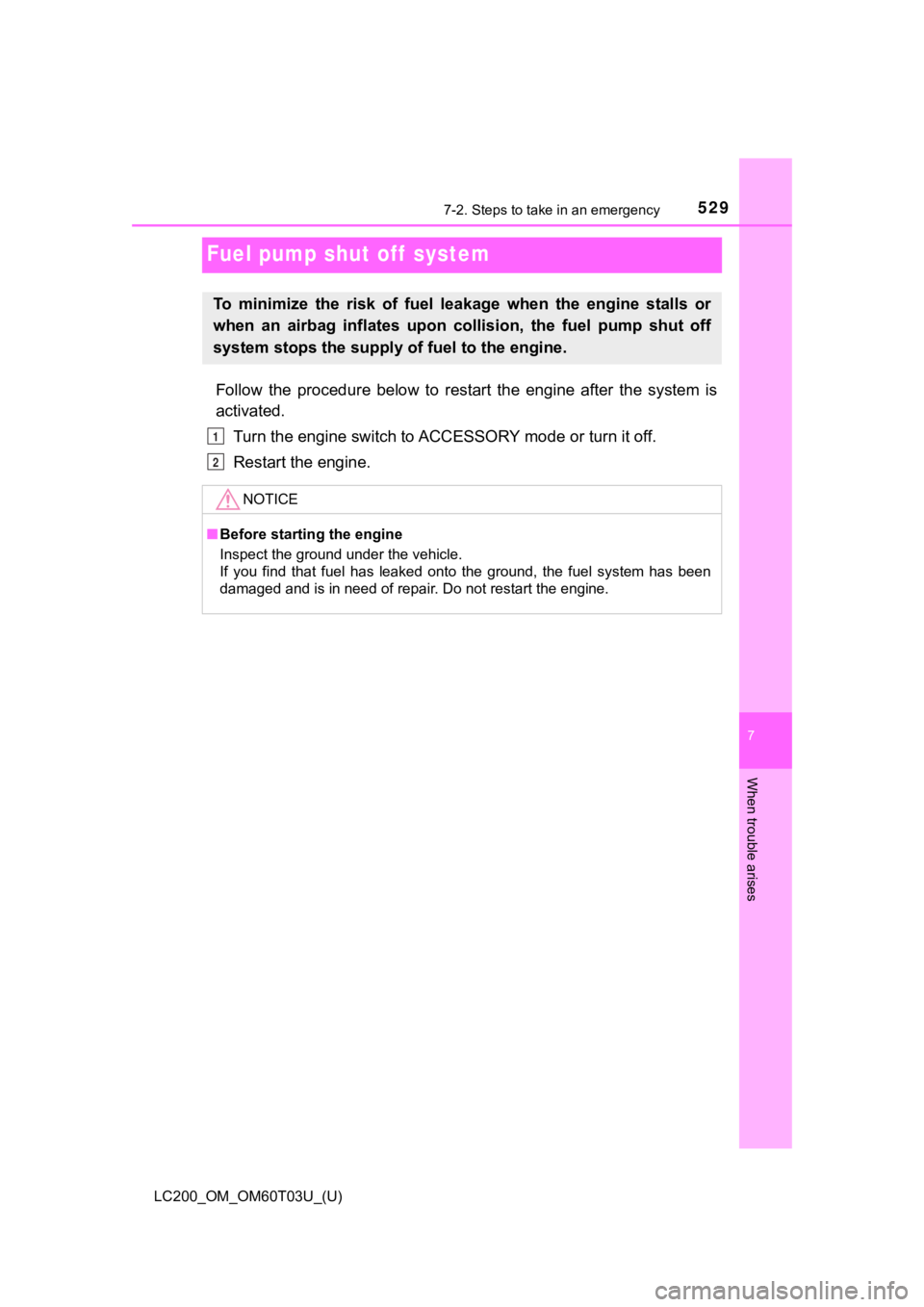
529
LC200_OM_OM60T03U_(U)
7
When trouble arises
7-2. Steps to take in an emergency
Fuel pump shut off system
Follow the procedure below to restart the engine after the system is
activated.
Turn the engine switch to ACCESSORY mode or turn it off.
Restart the engine.
To minimize the risk of fuel leakage when the engine stalls or
when an airbag inflates upon collision, the fuel pump shut off
system stops the supply of fuel to the engine.
NOTICE
■Before starting the engine
Inspect the ground under the vehicle.
If you find that fuel has leaked onto the ground, the fuel system has been
damaged and is in need of repair. Do not restart the engine.
1
2
Page 530 of 632
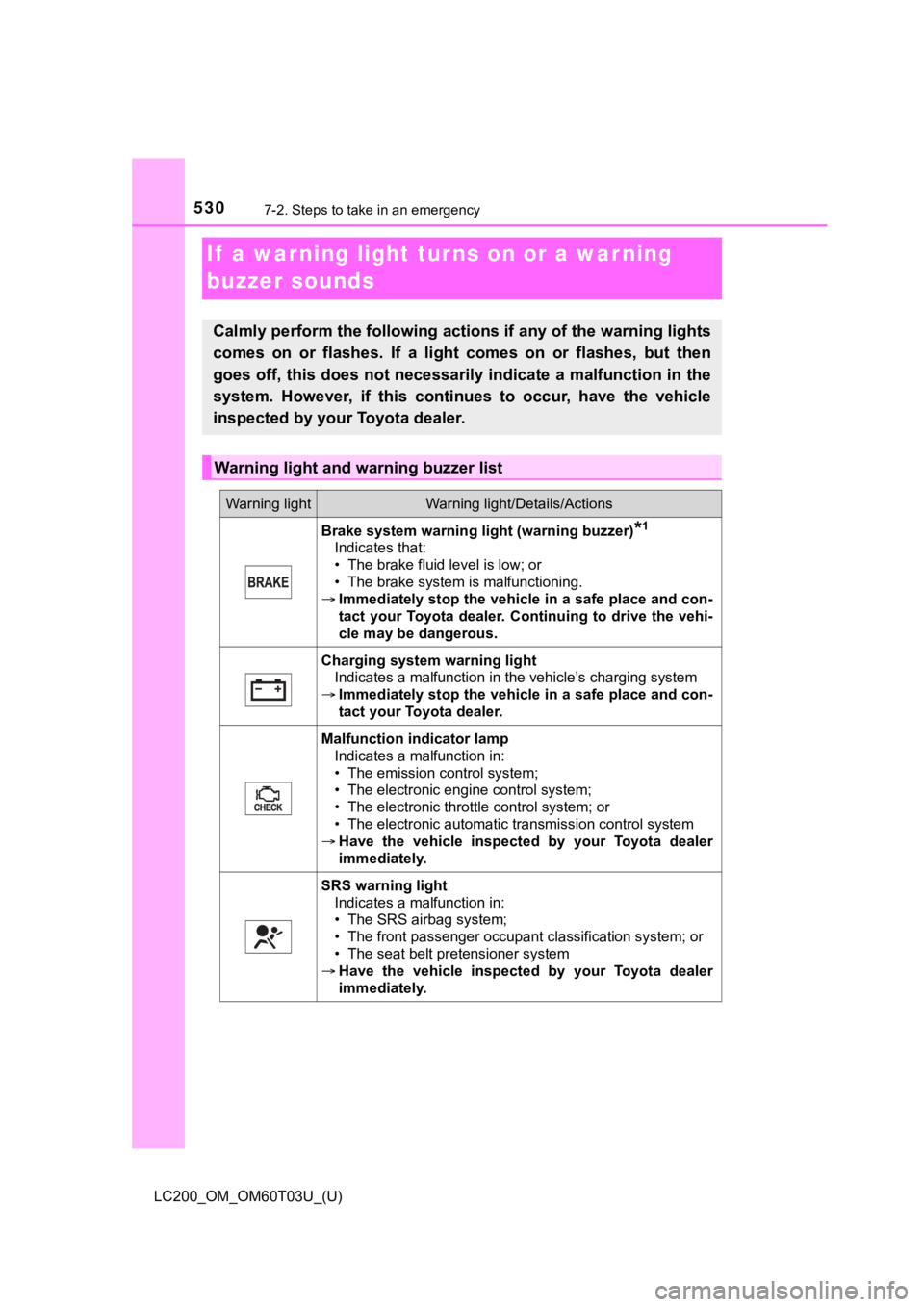
530
LC200_OM_OM60T03U_(U)
7-2. Steps to take in an emergency
If a warning light turns on or a war ning
buzzer sounds
Calmly perform the following actions if any of the warning ligh ts
comes on or flashes. If a light comes on or flashes, but then
goes off, this does not necessarily indicate a malfunction in the
system. However, if this continues to occur, have the vehicle
inspected by your Toyota dealer.
Warning light and w arning buzzer list
Warning lightWarning light/Details/Actions
Brake system warning li ght (warning buzzer)*1
Indicates that:
• The brake fluid level is low; or
• The brake system is malfunctioning.
Immediately stop the vehicle in a safe place and con-
tact your Toyota dealer. Continuing to drive the vehi-
cle may be dangerous.
Charging system warning light
Indicates a malfunction in the vehicle’s charging system
Immediately stop the vehicle in a safe place and con-
tact your Toyota dealer.
Malfunction indicator lamp
Indicates a malfunction in:
• The emission control system;
• The electronic engine control system;
• The electronic throttle control system; or
• The electronic automatic transmission control system
Have the vehicle inspected by your Toyota dealer
immediately.
SRS warning light
Indicates a malfunction in:
• The SRS airbag system;
• The front passenger occupant classification system; or
• The seat belt pretensioner system
Have the vehicle inspected by your Toyota dealer
immediately.